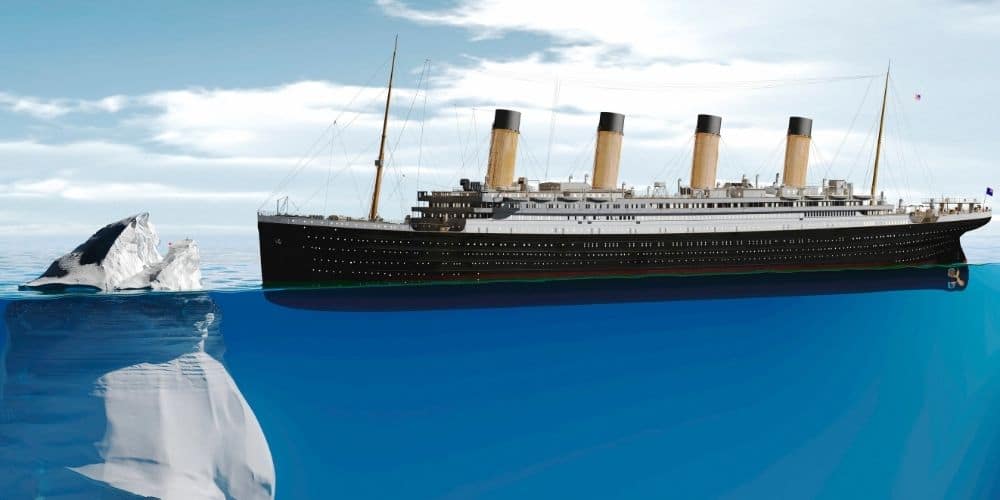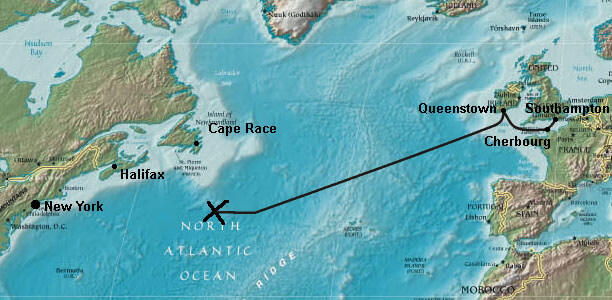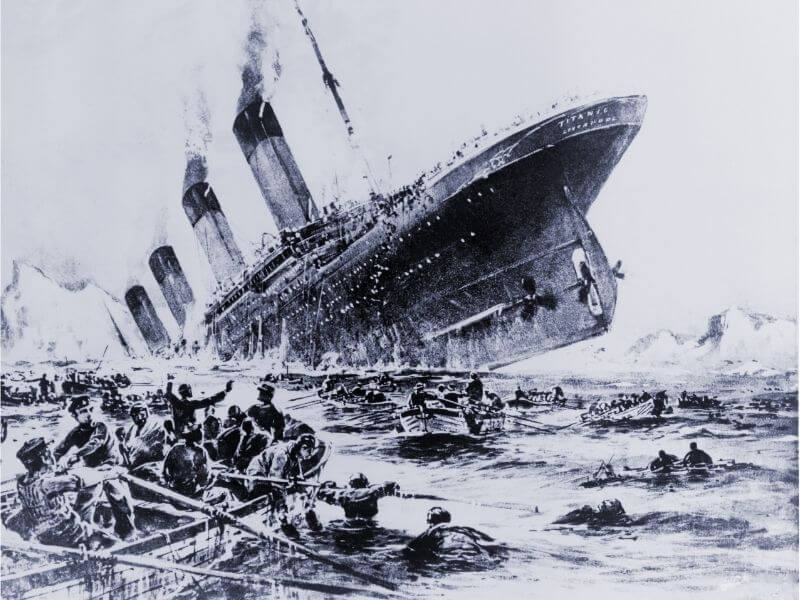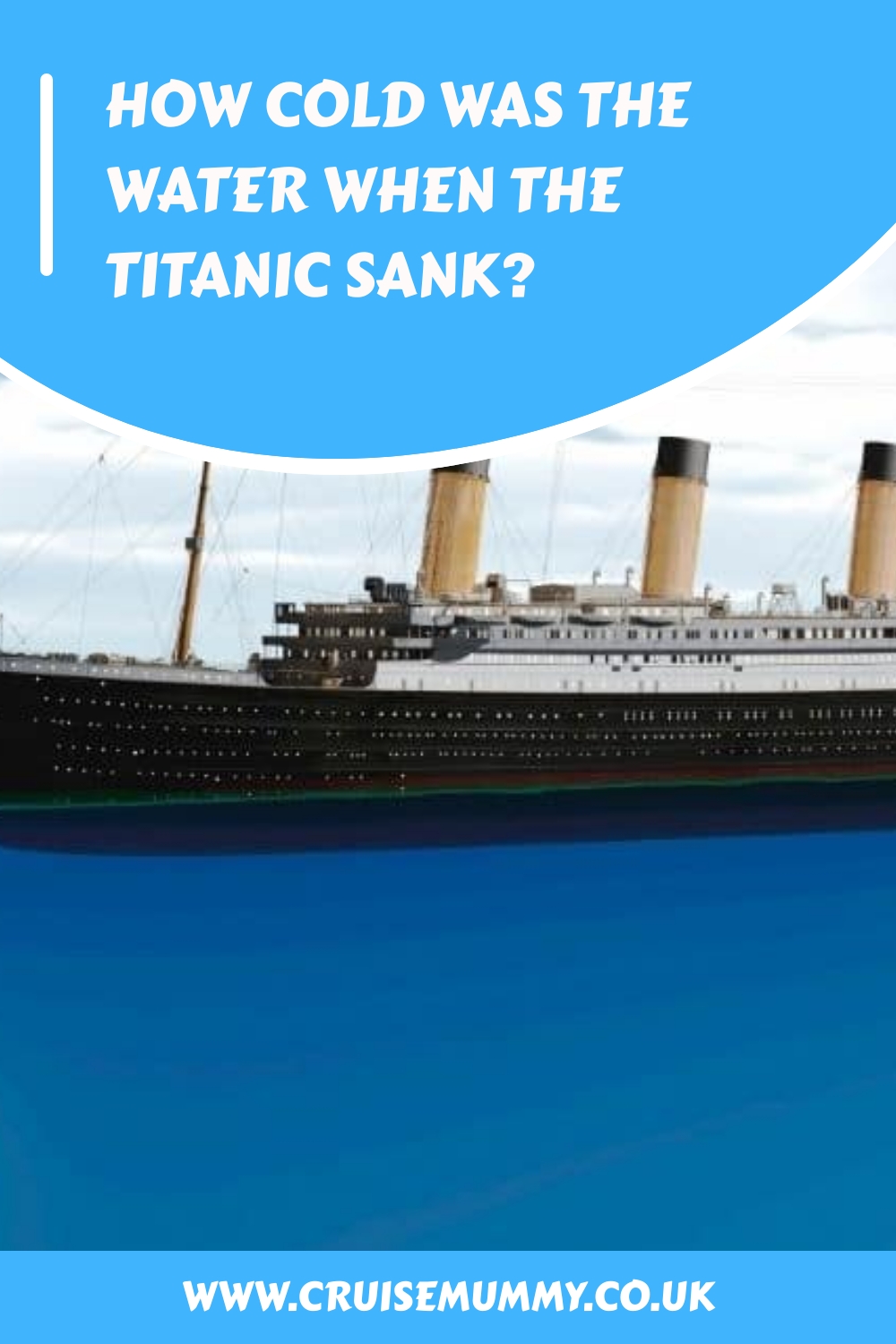The story of the Titanic was already a gripping one before the release of the movie in 1997. With over 1,500 deaths resulting from the sinking, it is one of the deadliest maritime disasters to have happened during peacetime.
Many of those died due to the shock of the cold water – but how cold was the Titanic water? I’m going to take you the key details in this article.

And because it’s such a popular question, I’m also going to explain what happened with Jack and Rose in the movie – and whether Jack could have survived.
The water temperature when the Titanic sank was 28°F or -2°C.
This is below freezing and is considered a lethal temperature. It is believed that most of the people in the water died as a result of the very low temperature.
Obviously, the waters were cold enough to sustain ice, as it was an iceberg that struck the ship and caused her to sink. The reason the ocean wasn’t frozen is because of the high salt content.
Passengers who were rescued by RMS Carpathia reported seeing huge sheets of ice with many icebergs once the sun had risen on the following day. The captain of that ship, Arthur Rostron, said that there were 20 large icebergs at least 200 feet tall in the waters.

Here’s why it was so cold
Part of the reason the air and water were so cold when the Titanic sank was due to a high-pressure cold front from eastern Canada. The ship also sank in the middle of the night, striking the iceberg at 11.40 pm, contributing to the cold temperatures of just 39°F (4°C) in the air and 28°F (-2°C) in the water.
This wasn’t unusual – the average temperature for the North Atlantic Ocean in the region where the Titanic sank varies between around -2 and 2 degrees centigrade during April.
This map shows the location where the Titanic sank…

Most of the Titanic victims died within 30 minutes of being in the water
There is some debate over the cause of death – it’s generally accepted now that hypothermia wasn’t a cause, but instead, most deaths were caused by cardiac arrest or other cold water shock-related issues.
According to Professor Michael Tipton of Portsmouth University, most people would have died due to the shock of the cold water causing them to hyperventilate, and therefore take on too much water, or simply because their heart couldn’t cope with the extra work and would have gone into cardiac arrest.
Only a few people in the water survived
It is believed that of the hundreds of people who fell into the water when the Titanic sank, between 44 and 48 people survived. Most of these were pulled into lifeboats quickly – many of the lifeboats were launched without being at full capacity, a contributing effect to the huge loss of life. [Source]

One famous survivor story is that of Charles Joughin, the head baker on the ship. He was heavily involved in the lifeboat operation – firstly arranging his baking crew to send large quantities of bread to stock the lifeboats, and then helping women and children into the lifeboats – sometimes forcibly, when women believed they were safer on the Titanic.
He was assigned the role of captain of Lifeboat 10 but declined to board, seeing that there were already two sailors and a steward on the boat. Instead, he went below deck, and had a drink, before returning to the deck and eventually going down with the ship, holding onto it as it sank and gently riding it into the water.
Unlike most of the others who fell into the water, Joughin survived for around two hours. Once day broke, he was able to swim to one of the lifeboats, and while there was no space for him to board he was able to hold the hand of a cook on the boat until he spotted another that he could swim to.
It’s theorised that one of the main reasons Joughin survived for so long was because he was under the influence of alcohol. While alcohol does increase the risk of hypothermia, it also has a calming effect, which could have helped Joughin avoid panicking from the cold water shock and allow him to tread water for as long as he did.
It may have also helped that this wasn’t Joughin’s first sinking – he had apparently been on board the SS Oregon when she sank in 1886. So he may have been less panicked than he would have been experiencing a sinking ship for the first time.
Suggested read: Are there still bodies in the Titanic?
If the Titanic sank in warm water, most would have survived
Almost all had life jackets on, and the lifeboat passengers were rescued only a couple of hours after the ship sank.
Passengers of sunken cruise ships can’t survive indefinitely though unless the water is tropical. While the people wouldn’t have suffered from cold water shock and would have lasted much longer if the Titanic had sunk in warmer water, the effects of hypothermia can still set in relatively quickly.
Hypothermia is when the body loses heat faster than it can generate it, which causes the body to begin to shut down and eventually die. The human body has a normal temperature of 98.6°F (37°C), and if it falls below 95°F (35°C) then hypothermia will set in.
Even in a water temperature of up to 70°F (21°C), people can die within just two hours. As a guide, the water temperature in the Caribbean is normally between 75 and 85 degrees. So maybe if the Titanic had sunk somewhere off the coast of Jamaica there would have been many more survivors.
However, it’s a strange hypothetical to even ask since the Titanic only sank after striking an iceberg. Had the water been warmer, the ship wouldn’t have even sunk in the first place – there wouldn’t have been an iceberg for the ship to hit.
Now, let’s get on to the all-important question that everyone asks at the end of the movie…
Yes, it’s annoying that Jack could have fit on the door with Rose
In terms of physical space, Jack and Rose could both have fit on the floating door debris at the end of the Titanic film. However, it would not have been buoyant enough to support them – they would’ve needed to use life jackets to support the frame.
Ever since the 1997 Titanic movie was released, fans (and non-fans, to be fair) have questioned whether Jack needed to die, since it looked like there was plenty of space for him on the broken door that Rose is floating on.
In the film, Jack manages to lift Rose onto the door and stays with her, both of them succumbing to the shock of the cold and passing out. When Rose is woken, she tries to wake Jack but sees that he has died.
Fans have argued that there was clearly space on the debris. Check out this recreation with possible ways they could both have had enough room to survive…
Jack and Rose could fit on that doorIn response though, the movie’s director James Cameron has argued that it was never about space, but buoyancy, saying that Jack’s extra weight would have caused the makeshift raft to sink. And that argument makes sense.
People couldn’t leave it alone though, and the show Mythbusters went one further by recreating the scene, testing whether tying Rose’s life jacket to the underside of the raft would have been sufficient to keep it afloat with both Jack and Rose’s weight.
They found that yes – the extra uplift created by the life jacket was enough.
James Cameron has seen this clip on Mythbusters, and had quite a short response – “I think you guys are missing the point here. The script says Jack dies. He has to die. So maybe we screwed up and the board should have been a little tiny bit smaller, but the dude’s going down.”
So, could Jack and Rose both have fit on the door? Technically maybe, but ultimately no, because the script says Jack dies.
Also, you could argue that while it’s possible the lifejacket would have created enough uplift, how would Jack and Rose have known that? And they likely wouldn’t have been thinking rationally due to the effects of the cold-water shock.
Suggested read: Was Titanic Filmed In A Pool?
Here’s why Jack and Rose didn’t take turns
If Jack and Rose had taken turns using the broken door as a makeshift raft, both would probably have died. The repeated exposure to freezing water and air, and the strenuous energy to climb onto the raft, would have exhausted both and caused them to drown or go into cardiac arrest.
There’s a lot less debate around this one despite it still being a popular question. While people have tried to argue that both could have fit on the raft, it’s quite simple that even trying to swap places back and forth would have been disastrous for the pair.
Scientifically, even Rose was lucky to survive having fallen into the water – the shock alone could have caused her to die in the low air temperatures.
And again, we can turn to James Cameron’s final argument on everything that happens in the movie – it happened the way it was scripted.
Despite Jack having a huge fanbase, he had to die for the movie to have the same emotional impact that it did.
To Conclude
In recent years, there have been advertising campaigns designed to help people who swim in the ocean to survive if caught in a riptide by telling them not to panic, as most of those who drowned did so because they tried to fight instead of float or tread water.
Now imagine how much worse it would have been for people who were already panicking after knowing the ship they were on was sinking, and then hitting freezing cold water. It’s an awful way for anyone to die, never mind around 1,500 people at the same time. The Titanic water temperature was lethal.

As for the popular movie – there’s no reasonable way that Jack could have survived. Even if he had been able to climb onto the raft, his weight would’ve sunk it and both Jack and Rose would’ve perished. Expecting Jack and Rose in their shocked states to understand how to tie a life jacket to the door is a little too much.
The real tragedy will always be the actual sinking of the ship back in 1912, but the one good thing that came from it was a revolution in regulations around lifeboat capacity and organisation, which would help ensure all future ship sailings were a lot safer.
Related Posts:
- Wonder of the Seas Vs Titanic
- Titanic Vs Modern Cruise Ships
- Titanic Route Map & Timetable
- The 10 Best Titanic Museums In The World

Jenni Fielding is the founder of Cruise Mummy. She has worked in the cruise industry since 2015 and has taken over 30 cruises. Now, she helps over 1 million people per month to plan their perfect cruise holidays.


